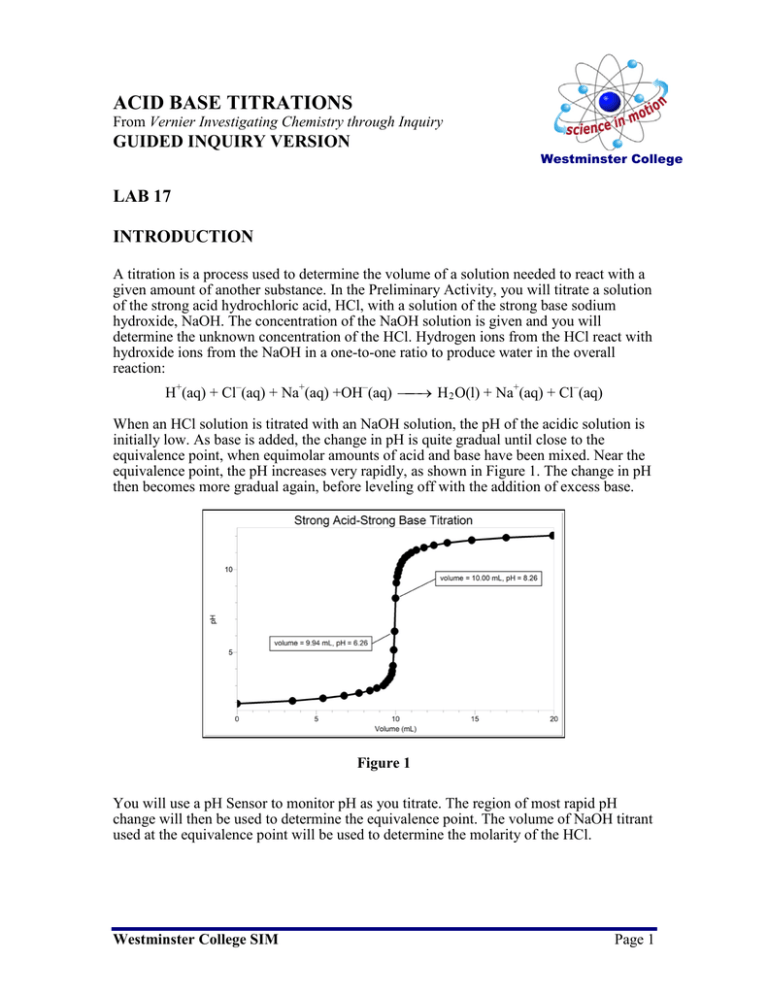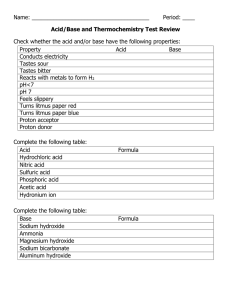ACID BASE TITRATIONS GUIDED INQUIRY VERSION LAB 17
advertisement

ACID BASE TITRATIONS From Vernier Investigating Chemistry through Inquiry GUIDED INQUIRY VERSION Westminster College LAB 17 INTRODUCTION A titration is a process used to determine the volume of a solution needed to react with a given amount of another substance. In the Preliminary Activity, you will titrate a solution of the strong acid hydrochloric acid, HCl, with a solution of the strong base sodium hydroxide, NaOH. The concentration of the NaOH solution is given and you will determine the unknown concentration of the HCl. Hydrogen ions from the HCl react with hydroxide ions from the NaOH in a one-to-one ratio to produce water in the overall reaction: H+(aq) + Cl–(aq) + Na+(aq) +OH–(aq) → H 2 O(l) + Na+(aq) + Cl–(aq) When an HCl solution is titrated with an NaOH solution, the pH of the acidic solution is initially low. As base is added, the change in pH is quite gradual until close to the equivalence point, when equimolar amounts of acid and base have been mixed. Near the equivalence point, the pH increases very rapidly, as shown in Figure 1. The change in pH then becomes more gradual again, before leveling off with the addition of excess base. Figure 1 You will use a pH Sensor to monitor pH as you titrate. The region of most rapid pH change will then be used to determine the equivalence point. The volume of NaOH titrant used at the equivalence point will be used to determine the molarity of the HCl. Westminster College SIM Page 1 ACID BASED TITRATIONS-GUIDED INQUIRY VERSION After completing the Preliminary Activity, you will investigate your assigned researchable question. Use reference sources to find out more about acids and bases and acid-base titrations before planning and conducting your investigation. SAFETY Both sodium hydroxide and Hydrochloric acid are harmful to skin and eyes. Wear eye protection! If any of either gets on skin or eyes rinse immediately and thoroughly with water. Never add water to acid. Always add acid to water. MATERIALS Labquest or Computer with Logger Pro Distilled Water 250 mL beakers HCL solution 10 mL pipet and bulb or pump Ph Sensor Hot plates with stir bars 50 mL burets and buret clamps .1M Sodium Hydroxide Solution PROCEDURE 1. Obtain and wear goggles. 2. Obtain about 25 mL of a hydrochloric acid solution of unknown concentration. Add 50 mL of distilled water to a 250 mL beaker. Use a pipet and a pipet bulb (or pipet pump) to transfer 10 mL of the HCl solution into the beaker. CAUTION: Handle the hydrochloric acid with care. It can cause painful burns if it comes in contact with the skin. 3. Place the beaker on a magnetic stirrer and add a stirring bar. If no magnetic stirrer is available, stir the reaction mixture with a stirring rod during the titration. Westminster College SIM Page 2 ACID BASED TITRATIONS-GUIDED INQUIRY VERSION 4. Set up the data-collection system. a. Connect the pH Sensor and the data-collection interface. b. Start the data-collection program. c. Set up data collection for Events with Entry mode. 5. Use a utility clamp to suspend the pH Sensor on the ring stand (see Figure 2). Position the pH Sensor so that its tip is immersed in the HCl solution but is not struck by the stirring bar. Gently stir the beaker of acid solution. 6. Rinse and fill a 50.0 mL buret with ~0.1 M NaOH solution. Attach the buret to the ring stand using a buret clamp (see Figure 2). Note: Record the precise concentration of the NaOH solution in your data table. CAUTION: Sodium hydroxide solution is caustic. Avoid spilling it on your skin or clothing. Figure 2 7. Conduct the titration carefully. Listed below is a suggested method for performing a titration. a. Determine an initial pH reading, before adding any NaOH solution. b. Add NaOH in small increments that raise the pH of the mixture by about 0.15 units at a time, until you reach a pH of about 3.5. c. At this point, add NaOH drop by drop. Continue in this manner until you have recorded data through the equivalence point. d. When the pH of the mixture is about 10, add larger amounts of NaOH that raise the pH by about 0.15 units until the pH remains constant. 8. When you have finished the titration, dispose of the reaction mixture as directed. Rinse the pH Sensor with distilled water. Westminster College SIM Page 3 ACID BASED TITRATIONS-GUIDED INQUIRY VERSION QUESTIONS 1. At the equivalence point, equimolar amounts of HCl and NaOH have been mixed. The equivalence point is characterized by the largest increase in pH upon the addition of a very small amount of NaOH solution. Find that largest pH increase in your data. Add the NaOH volumes before and after the largest increase and divide by two to determine the volume of NaOH added at the equivalence point. (Alternatively, the equivalence point can be precisely determined with the use of the second derivative of the pH-volume data. The equivalent point corresponds to the volume where the second derivative equals zero on the second derivative plot.) 2. Calculate the number of moles of NaOH used. 3. Using the equation for the neutralization reaction given in the introduction, determine the number of moles of HCl used. 4. Calculate the HCl concentration using the pipeted volume of unknown HCl. Note: The plan that you submit for instructor approval should list laboratory safety concerns, including chemical safety concerns, and specify how you will address these safety concerns during your investigation. Westminster College SIM Page 4







